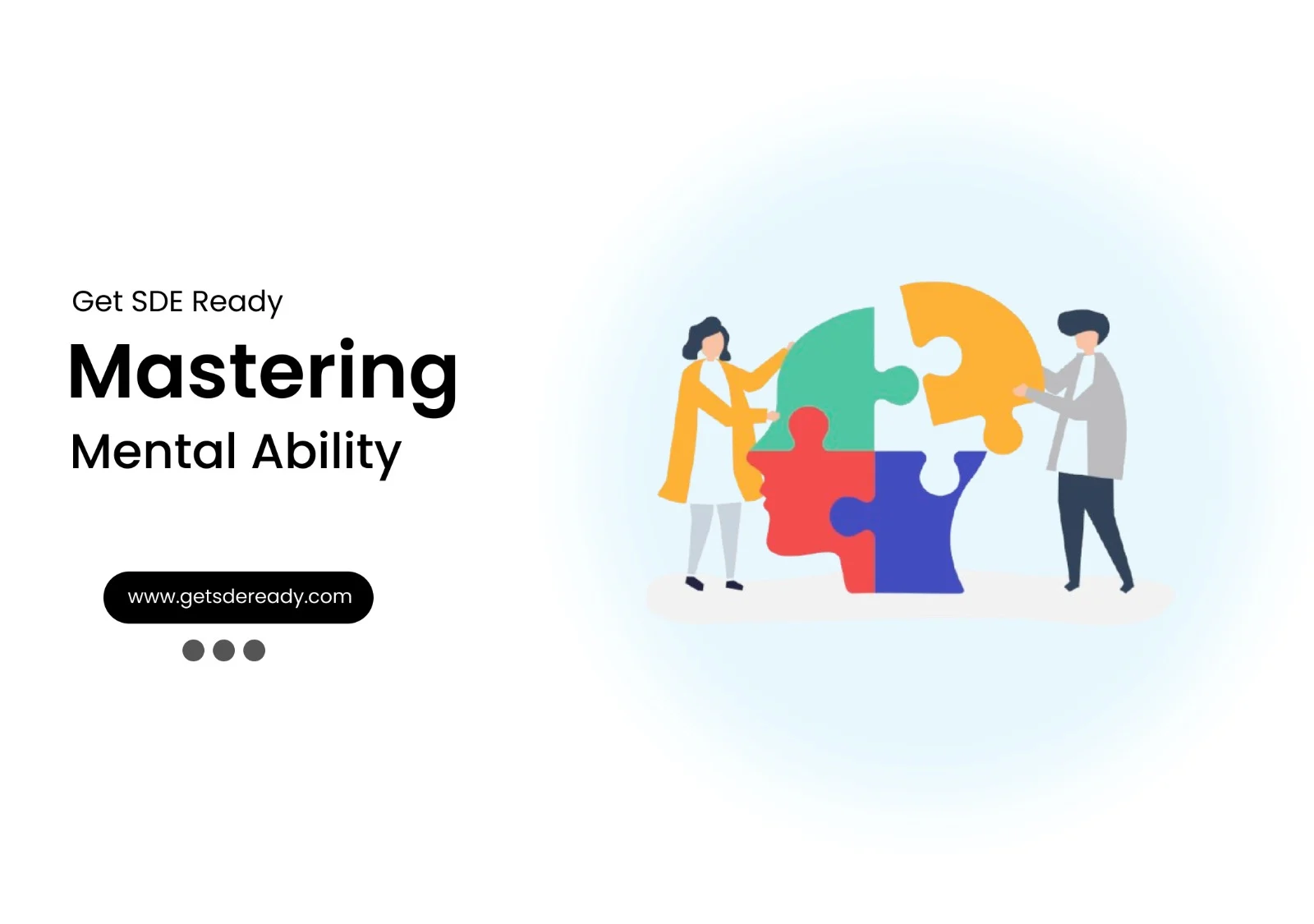Data Structures and Algorithms
- Introduction to Data Structures and Algorithms
- Time and Space Complexity Analysis
- Big-O, Big-Theta, and Big-Omega Notations
- Recursion and Backtracking
- Divide and Conquer Algorithm
- Dynamic Programming: Memoization vs. Tabulation
- Greedy Algorithms and Their Use Cases
- Understanding Arrays: Types and Operations
- Linear Search vs. Binary Search
- Sorting Algorithms: Bubble, Insertion, Selection, and Merge Sort
- QuickSort: Explanation and Implementation
- Heap Sort and Its Applications
- Counting Sort, Radix Sort, and Bucket Sort
- Hashing Techniques: Hash Tables and Collisions
- Open Addressing vs. Separate Chaining in Hashing
- DSA Questions for Beginners
- Advanced DSA Questions for Competitive Programming
- Top 10 DSA Questions to Crack Your Next Coding Test
- Top 50 DSA Questions Every Programmer Should Practice
- Top Atlassian DSA Interview Questions
- Top Amazon DSA Interview Questions
- Top Microsoft DSA Interview Questions
- Top Meta (Facebook) DSA Interview Questions
- Netflix DSA Interview Questions and Preparation Guide
- Top 20 DSA Interview Questions You Need to Know
- Top Uber DSA Interview Questions and Solutions
- Google DSA Interview Questions and How to Prepare
- Airbnb DSA Interview Questions and How to Solve Them
- Mobile App DSA Interview Questions and Solutions
DSA Interview Questions
- DSA Questions for Beginners
- Advanced DSA Questions for Competitive Programming
- Top 10 DSA Questions to Crack Your Next Coding Test
- Top 50 DSA Questions Every Programmer Should Practice
- Top Atlassian DSA Interview Questions
- Top Amazon DSA Interview Questions
- Top Microsoft DSA Interview Questions
- Top Meta (Facebook) DSA Interview Questions
- Netflix DSA Interview Questions and Preparation Guide
- Top 20 DSA Interview Questions You Need to Know
- Top Uber DSA Interview Questions and Solutions
- Google DSA Interview Questions and How to Prepare
- Airbnb DSA Interview Questions and How to Solve Them
- Mobile App DSA Interview Questions and Solutions
Introduction to High-Level System Design
System Design Fundamentals
- Functional vs. Non-Functional Requirements
- Scalability, Availability, and Reliability
- Latency and Throughput Considerations
- Load Balancing Strategies
Architectural Patterns
- Monolithic vs. Microservices Architecture
- Layered Architecture
- Event-Driven Architecture
- Serverless Architecture
- Model-View-Controller (MVC) Pattern
- CQRS (Command Query Responsibility Segregation)
Scaling Strategies
- Vertical Scaling vs. Horizontal Scaling
- Sharding and Partitioning
- Data Replication and Consistency Models
- Load Balancing Strategies
- CDN and Edge Computing
Database Design in HLD
- SQL vs. NoSQL Databases
- CAP Theorem and its Impact on System Design
- Database Indexing and Query Optimization
- Database Sharding and Partitioning
- Replication Strategies
API Design and Communication
Caching Strategies
- Types of Caching
- Cache Invalidation Strategies
- Redis vs. Memcached
- Cache-Aside, Write-Through, and Write-Behind Strategies
Message Queues and Event-Driven Systems
- Kafka vs. RabbitMQ vs. SQS
- Pub-Sub vs. Point-to-Point Messaging
- Handling Asynchronous Workloads
- Eventual Consistency in Distributed Systems
Security in System Design
Observability and Monitoring
- Logging Strategies (ELK Stack, Prometheus, Grafana)
- API Security Best Practices
- Secure Data Storage and Access Control
- DDoS Protection and Rate Limiting
Real-World System Design Case Studies
- Distributed locking (Locking and its Types)
- Memory leaks and Out of memory issues
- HLD of YouTube
- HLD of WhatsApp
System Design Interview Questions
- Adobe System Design Interview Questions
- Top Atlassian System Design Interview Questions
- Top Amazon System Design Interview Questions
- Top Microsoft System Design Interview Questions
- Top Meta (Facebook) System Design Interview Questions
- Top Netflix System Design Interview Questions
- Top Uber System Design Interview Questions
- Top Google System Design Interview Questions
- Top Apple System Design Interview Questions
- Top Airbnb System Design Interview Questions
- Top 10 System Design Interview Questions
- Mobile App System Design Interview Questions
- Top 20 Stripe System Design Interview Questions
- Top Shopify System Design Interview Questions
- Top 20 System Design Interview Questions
- Top Advanced System Design Questions
- Most-Frequented System Design Questions in Big Tech Interviews
- What Interviewers Look for in System Design Questions
- Critical System Design Questions to Crack Any Tech Interview
- Top 20 API Design Questions for System Design Interviews
- Top 10 Steps to Create a System Design Portfolio for Developers
Top 50 DSA Questions Every Programmer Should Practice
Discover the essential DSA questions that can sharpen your coding skills and boost your interview readiness. In this comprehensive guide, we explore the top 50 data structures and algorithms questions that every programmer should master. Whether you are a beginner or an experienced developer, this article is designed to help you build a robust foundation in DSA. If you’re looking for free courses or the latest course updates, feel free to check out our lead capture form here.
Introduction to Data Structures and Algorithms
Data Structures and Algorithms (DSA) are the backbone of efficient programming. Mastering DSA not only improves your coding skills but also helps you tackle complex challenges in technical interviews. By understanding how data is stored, managed, and manipulated, you can optimize performance and solve problems faster.
Learning DSA allows programmers to design scalable software solutions. In many competitive programming scenarios and coding interviews, questions on DSA test your problem-solving abilities. As stated by computer science experts, “a strong grasp of DSA is a must-have for any serious developer.” This article compiles 50 critical questions that have proven to be challenging and insightful across various coding platforms.
- Bullet Points of Key Benefits:
- Enhances problem-solving skills
- Improves algorithmic thinking
- Increases coding efficiency
- Boosts interview confidence
Consider the fact that many top tech companies prioritize candidates with proven DSA skills, emphasizing its industry-wide importance.
Also Read: Low-Level Design of YouTube Recommendations
Importance of DSA in Programming Careers
The role of DSA in a programmer’s career is paramount. With rapidly evolving technology and increasing complexity in software systems, employers look for candidates who can think critically about problem solving. DSA not only helps in interviews but also in writing efficient code that performs well under pressure.
Employers often cite DSA expertise as a key indicator of a candidate’s ability to handle real-world problems. As a result, programmers who invest time in mastering DSA find themselves better equipped to solve algorithmic challenges and optimize existing systems. According to industry statistics, programmers who excel in DSA tend to secure higher-paying roles and have better career progression opportunities.
- Quick Facts:
- Over 70% of technical interviews include DSA problems.
- A well-prepared candidate can solve problems 30% faster.
- Companies like Google, Amazon, and Facebook heavily emphasize DSA skills.
The logical reasoning and analytical skills developed through DSA practice are essential assets for any programming career.
Also Read: Top 10 DSA Questions on Linked Lists and Arrays
Overview of the Top 50 DSA Questions
When preparing for technical interviews, a curated list of 50 essential DSA questions can serve as a reliable roadmap. These questions span across multiple categories such as arrays, strings, linked lists, trees, graphs, dynamic programming, and more. Each question is designed to test various aspects of your understanding, from basic operations to complex problem-solving.
The questions are categorized to help you target specific areas of weakness or strength. For example, you might focus on arrays and strings one day and tackle dynamic programming challenges the next. This comprehensive approach ensures that you are well-rounded in your understanding and application of DSA concepts. In addition, the curated list is supported by statistical evidence and expert recommendations, making it a trusted resource for both novices and seasoned developers.
- Table: Example Categories and Question Focus
Category | Focus Area | Example Question Type |
Arrays & Strings | Basic manipulation & searching | Find the longest substring without repeating characters |
Linked Lists | Node traversal & manipulation | Reverse a linked list |
Stacks & Queues | Order management & algorithmic flow | Implement a queue using two stacks |
Trees | Hierarchical data processing | Determine the depth of a binary tree |
Graphs | Pathfinding and connectivity | Detect a cycle in a directed graph |
This structured approach not only improves your problem-solving skills but also ensures that you cover the broad spectrum of DSA topics essential for modern programming challenges.
Also Read: Top 20 Full Stack Developer Web Dev Questions
Detailed Breakdown of DSA Categories and Questions
Delving deeper into the DSA world, we categorize the top 50 questions by topic. This section provides a detailed breakdown with explanations, sample problems, and practice tips for each category.
Arrays and Strings
Arrays and strings are fundamental to most programming languages. They serve as the building blocks for more complex data structures and algorithms. Questions in this category often focus on searching, sorting, and manipulating data.
- Key Concepts:
- Indexing and traversal techniques
- Two-pointer approaches
- Sliding window algorithms
Sample Questions:
- Find the maximum subarray sum using Kadane’s algorithm.
- Reverse a string without using extra space.
Benefits:
- Improves understanding of memory management.
- Enhances skills in algorithm optimization.
Bullet Points for Quick Review:
- Understand basic iteration and recursion.
- Practice edge case handling (e.g., empty strings, negative indices).
- Use example problems to reinforce learning.
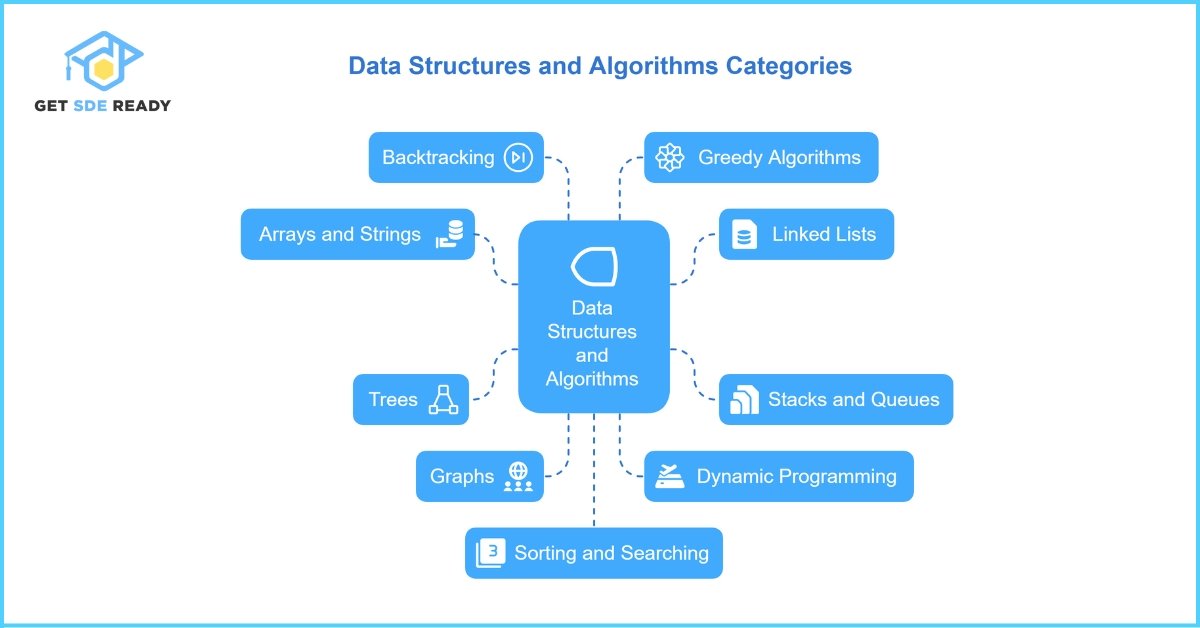
Linked Lists
Linked lists are essential for dynamic memory allocation and efficient insertion/deletion operations. The questions here test your ability to manipulate pointers and traverse linked structures.
- Key Concepts:
- Singly vs. doubly linked lists
- Cycle detection using Floyd’s algorithm
- Insertion and deletion strategies
Sample Questions:
- Reverse a linked list iteratively and recursively.
- Detect and remove a loop in a linked list.
Advantages:
- Provides insights into dynamic data handling.
- Enhances problem-solving skills related to pointer manipulation.
Bullet Points for Quick Revision:
- Learn to implement and traverse linked lists.
- Focus on edge cases like empty lists and single-node scenarios.
- Analyze time and space complexities.
Stacks and Queues
Stacks and queues are linear data structures that support order-specific operations. These questions help you understand the last-in-first-out (LIFO) and first-in-first-out (FIFO) principles.
- Key Concepts:
- Stack operations: push, pop, and peek
- Queue operations: enqueue, dequeue
- Implementation using arrays or linked lists
Sample Questions:
- Evaluate postfix expressions using stacks.
- Implement a queue using two stacks.
Core Benefits:
- Enhances understanding of algorithmic flow.
- Improves coding efficiency in managing order-specific tasks.
Bullet Points:
- Practice using stacks for function call management.
- Understand queue-based scheduling algorithms.
- Compare different implementations for performance.
Trees
Trees are hierarchical data structures that are crucial for various applications like file systems and databases. Questions on trees often focus on traversal, insertion, and deletion operations.
- Key Concepts:
- Binary trees and binary search trees (BST)
- Tree traversals: inorder, preorder, and postorder
- Balancing trees (AVL, Red-Black Trees)
Sample Questions:
- Find the height of a binary tree.
- Perform level order traversal using queues.
Advantages:
- Reinforces the concept of hierarchical data management.
- Offers practice on recursive and iterative approaches.
Bullet Points:
- Understand different tree traversal methods.
- Learn to balance trees for optimized performance.
- Use diagrams to illustrate tree structures.
Graphs
Graphs represent interconnected data and are pivotal in network analysis, social media, and route planning. DSA questions on graphs test your ability to manage nodes and edges effectively.
- Key Concepts:
- Graph representations: adjacency list and matrix
- Traversal algorithms: DFS and BFS
- Shortest path algorithms: Dijkstra’s, Bellman-Ford
Sample Questions:
- Determine if a graph is bipartite.
- Find the shortest path in a weighted graph.
Core Benefits:
- Improves understanding of complex data interconnections.
- Strengthens algorithmic thinking in network flow problems.
Bullet Points:
- Practice implementing both DFS and BFS.
- Understand the differences between various shortest path algorithms.
- Focus on both directed and undirected graphs.
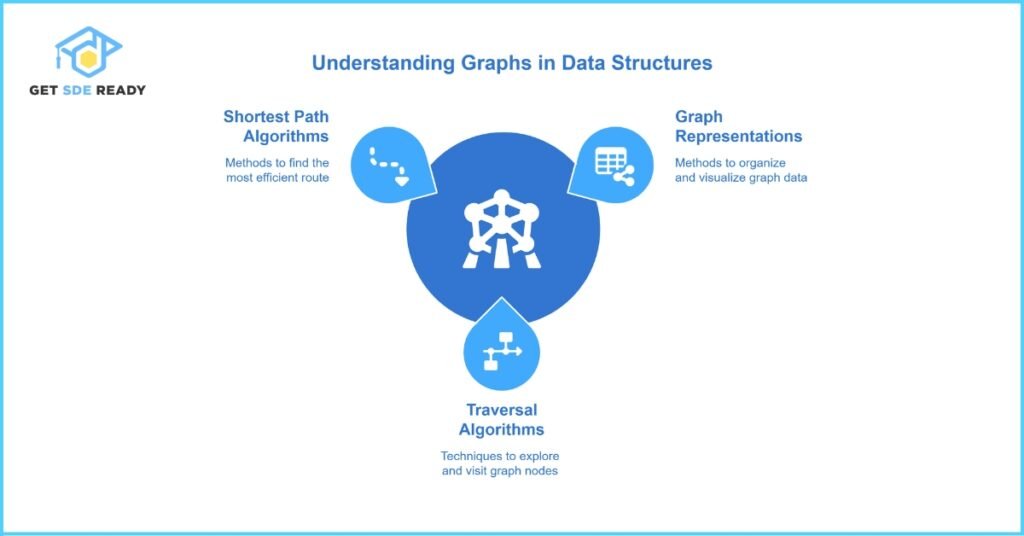
Dynamic Programming
Dynamic Programming (DP) is a powerful technique used to solve optimization problems. Questions in this category require breaking down problems into simpler subproblems.
- Key Concepts:
- Overlapping subproblems and optimal substructure
- Memoization vs. tabulation
- Common DP patterns
Sample Questions:
- Compute the Fibonacci sequence using DP.
- Solve the knapsack problem using bottom-up approach.
Advantages:
- Enhances logical thinking by teaching problem decomposition.
- Provides a framework for solving complex optimization problems.
Bullet Points:
- Identify and solve overlapping subproblems.
- Learn to optimize recursive solutions with memoization.
- Practice with classic DP problems for mastery.
Backtracking
Backtracking is a strategy for solving constraint satisfaction problems. It is especially useful in puzzles and combinatorial problems.
- Key Concepts:
- Recursive problem solving
- Pruning unnecessary paths
- Constraint handling
Sample Questions:
- Solve the N-Queens problem.
- Generate all permutations of a given set.
Benefits:
- Encourages creative problem-solving.
- Teaches the importance of exploring all possibilities systematically.
Bullet Points:
- Practice recursive functions with backtracking.
- Focus on identifying valid and invalid paths.
- Analyze the efficiency of backtracking algorithms.
Greedy Algorithms
Greedy algorithms are used for optimization problems where local choices lead to global solutions. These questions are designed to test your ability to make optimal choices at each step.
- Key Concepts:
- Greedy choice property
- Optimal substructure
- Common greedy algorithm patterns
Sample Questions:
- Solve the coin change problem using a greedy approach.
- Implement Kruskal’s algorithm for minimum spanning tree.
Advantages:
- Provides quick solutions to optimization problems.
- Enhances understanding of algorithmic trade-offs.
Bullet Points:
- Understand when a greedy algorithm is applicable.
- Practice making locally optimal decisions.
- Compare greedy solutions with dynamic programming approaches.
Sorting and Searching
Sorting and searching algorithms are fundamental for data manipulation and retrieval. They form the basis of many complex systems and applications.
- Key Concepts:
- Various sorting techniques (QuickSort, MergeSort, etc.)
- Binary search and its applications
- Time complexity analysis
Sample Questions:
- Implement MergeSort and analyze its complexity.
- Perform binary search on a sorted array.
Benefits:
- Provides a strong foundation in algorithmic efficiency.
- Critical for optimizing search operations in large datasets.
Bullet Points:
- Compare different sorting algorithms for performance.
- Understand the binary search algorithm’s steps.
- Use tables to illustrate time complexity comparisons.
Hashing and Maps
Hashing is a technique for efficiently mapping data using keys. Questions in this category often involve collision handling and designing hash tables.
- Key Concepts:
- Hash functions and collision resolution
- Implementing hash maps and dictionaries
- Performance considerations in hashing
Sample Questions:
- Design a hash table from scratch.
- Solve problems using hash maps to store frequency counts.
Core Benefits:
- Enhances data retrieval efficiency.
- Provides a foundation for understanding database indexing.
Bullet Points:
- Learn to implement basic hash functions.
- Understand methods like chaining and open addressing.
- Practice with problems that require constant time lookups.
Also Read: Top 10 System Design Interview Questions 2025
Strategies to Practice and Master DSA Questions
A well-planned strategy is crucial for mastering DSA questions. Effective practice not only improves your coding speed but also your problem-solving approach. Here are several strategies to help you maximize your preparation.
Effective Study Techniques
Focus on a consistent study schedule and set measurable goals. Break down each topic into manageable parts and devote time to understanding core concepts. Practice with incremental difficulty levels, starting from basic problems and moving to advanced challenges.
- Key Techniques:
- Daily problem-solving sessions
- Reviewing solved problems for patterns
- Using flashcards to remember key concepts
Table: Study Technique Comparison
Technique | Pros | Cons |
Daily Problem Solving | Consistent improvement, builds muscle memory | Can be time-consuming |
Reviewing Past Problems | Reinforces learned concepts | May require additional resources |
Flashcards | Quick recall of definitions and patterns | Not effective for complex problems |
Utilizing Online Resources
Leverage interactive coding platforms, video tutorials, and community forums. Websites like LeetCode, HackerRank, and CodeChef offer a plethora of problems and user discussions. These resources provide diverse approaches to similar problems, which enrich your understanding.
- Resource Benefits:
- Exposure to various problem-solving methods
- Access to expert explanations and tutorials
- Opportunities to engage with a community of learners
Mock Interviews and Practice Platforms
Engaging in mock interviews can simulate the pressure of a real technical interview. Practice platforms provide a controlled environment to hone your skills. Recording your sessions and reviewing mistakes can be a great way to identify areas for improvement.
- Practice Tips:
- Set up timed sessions to mimic interview conditions.
- Use online coding simulators to gauge your progress.
- Get feedback from peers or mentors.
Time Management and Problem Solving
Managing time during practice is as important as solving the problem. Allocate specific time frames for each question and move on if stuck. This approach prevents spending too much time on a single problem and promotes overall progress.
- Bullet Points for Time Management:
- Set a timer for each practice session.
- Identify and review problems that take longer than expected.
- Maintain a log to track improvements over time.
Also Read: Why System Design Interviews Are Tough
Common Mistakes and How to Avoid Them
Even seasoned programmers can fall into common pitfalls when preparing for DSA interviews. Recognizing and learning from these mistakes can streamline your preparation process and improve your overall performance.
Pitfalls in Approaching DSA
One frequent mistake is diving into complex problems without a solid grasp of fundamentals. This often leads to frustration and incomplete solutions. Instead, build a strong foundation by mastering the basics before moving on to more advanced topics.
- Common Errors:
- Overcomplicating simple problems
- Ignoring base cases and edge scenarios
- Lack of systematic debugging strategies
Overlooking Edge Cases
Many candidates fail to account for edge cases, leading to incorrect or inefficient solutions. Testing your code with a variety of inputs can highlight hidden issues. This practice not only improves your coding quality but also prepares you for unexpected challenges during interviews.
- Key Points:
- Always consider scenarios like empty inputs, maximum/minimum values, and null cases.
- Use example inputs to validate your algorithms.
- Implement robust error handling to manage unforeseen conditions.
Inefficient Coding Practices
Writing code that works is one thing; writing efficient code is another. Many developers focus solely on getting the correct output rather than optimizing for time and space. Avoid using brute-force methods when more refined algorithms are available.
- Bullet Points:
- Analyze the time and space complexity of your solution.
- Refactor your code for better readability and performance.
- Use performance benchmarks to compare different approaches.
Neglecting Complexity Analysis
A comprehensive understanding of algorithmic complexity is critical for choosing the best solution. Candidates often overlook this analysis, which can result in suboptimal code under competitive conditions. Learning how to estimate the Big O notation of your solution is crucial for success.
- Practical Tips:
- Regularly review complexity analysis for each problem solved.
- Compare multiple solutions for the same problem.
- Incorporate complexity analysis into your practice routine.
Also Read: Top 20 API and RESULT ful Design Questions
Additional Resources and Next Steps
As you progress through the top 50 DSA questions, exploring additional resources and mapping your next steps is essential. Building a network of learning and constantly challenging yourself will keep you ahead in your programming career.
Recommended Books and Courses
Investing in quality educational resources can provide in-depth explanations and a structured learning path. Books like “Introduction to Algorithms” by Cormen et al. and online courses can be invaluable in your journey.
- Notable Recommendations:
- “Introduction to Algorithms” by Cormen, Leiserson, Rivest, and Stein
- Online platforms offering interactive DSA courses
Comparison Table:
Resource Type | Pros | Cons |
Books | In-depth knowledge, long-term reference | May be less interactive |
Online Courses | Structured, interactive, and up-to-date | Often require a subscription |
Coding Platforms | Practice with real-world problems | Limited theoretical explanations |
Joining Coding Communities
Engage with communities on platforms like GitHub, Stack Overflow, and coding forums. Sharing experiences and solutions with peers fosters a collaborative learning environment.
- Benefits:
- Learn from real-life experiences of other programmers.
- Receive feedback on your solutions.
- Stay updated with the latest industry trends and best practices.
Regular Assessment and Feedback
Taking periodic assessments can help track your progress. Participate in coding contests and peer reviews to identify areas that need improvement. Use the feedback to refine your approach and improve your problem-solving skills.
- Bullet Points for Self-Assessment:
- Schedule regular mock tests.
- Maintain a log of solved and unsolved problems.
- Use analytics from coding platforms to monitor improvement.
Also Read: How to Crack DSA Interviews in 3 Months
Advanced Topics in DSA
For programmers who are comfortable with the basics, diving into advanced DSA topics can provide a competitive edge. These advanced concepts integrate DSA with real-world applications and system design challenges.
Integration with System Design
Modern software engineering often requires blending DSA with system design principles. Understanding how algorithms work within a larger system is crucial for building scalable and efficient applications. Advanced questions may combine data structure manipulations with design constraints.
- Key Integration Points:
- How DSA influences system performance
- Combining algorithm optimization with database design
- Real-world case studies that highlight integration challenges
Bullet Points:
- Explore hybrid approaches that combine DSA and system design.
- Study case studies of high-scale applications.
- Analyze trade-offs between theoretical and practical implementations.
Real-World Application Scenarios
Advanced DSA questions often stem from real-world problems. This section highlights case studies and examples from industries such as finance, healthcare, and e-commerce. Learning from these scenarios can provide insights into applying theory to practice.
- Example Applications:
- Real-time data processing in financial systems
- Optimizing search algorithms for e-commerce platforms
- Developing efficient routing algorithms for transportation networks
Industry Trends and Future Directions
Staying updated on emerging trends is vital for continuous learning. The rapid evolution of technology means that new algorithms and data structures are constantly being developed. Keeping an eye on research papers and tech blogs can help you stay ahead.
- Trends to Watch:
- The impact of artificial intelligence on algorithm development
- New data structures designed for big data applications
- The role of quantum computing in algorithm optimization
Also Read: Top 15 Full-Stack Dev Interview Questions 2025
Real Interview Experiences and Case Studies
Learning from real interview experiences can be invaluable in preparing for technical interviews. In this section, we share success stories, common challenges faced by candidates, and insightful feedback from recruiters.
Success Stories
Many programmers have transformed their careers by mastering DSA. Real-life examples illustrate how dedicated practice and consistent learning can lead to impressive interview outcomes. Success stories provide motivation and actionable strategies for your own preparation.
- Key Takeaways:
- Consistent practice pays off.
- Learning from failures is a stepping stone to success.
- Peer support and mentorship accelerate progress.
Challenges Faced by Candidates
Interviews often present unexpected challenges that test not just technical skills but also mental resilience. Common hurdles include time pressure, ambiguous problem statements, and stress management. Learning to overcome these challenges is essential for long-term success.
- Common Challenges:
- Managing anxiety during coding rounds.
- Handling questions that require out-of-the-box thinking.
- Adapting to rapidly changing problem statements.
Feedback from Recruiters
Recruiters emphasize clarity, efficiency, and systematic thinking in candidate solutions. Constructive feedback from interviewers can help you identify your weak spots and work on them systematically. Many recruiters recommend a balanced approach between coding practice and theoretical study.
- Bullet Points:
- Emphasize clear communication of your thought process.
- Optimize your code for efficiency and readability.
- Always explain your reasoning during interviews.
Also Read: System Design for Real-Time Chat Apps
Tools and Platforms for DSA Practice
A variety of tools and platforms can assist in your DSA journey. Using interactive platforms can help you simulate real interview conditions and improve your coding skills through practical experience.
Popular Coding Platforms
There are numerous platforms available where you can practice DSA problems and participate in coding contests. These platforms often provide detailed problem explanations, discussion forums, and performance analytics.
- Top Platforms:
- LeetCode: Offers a wide range of problems and mock interviews.
- HackerRank: Provides contests and a supportive community.
- CodeChef: Known for its competitive programming challenges.
Interactive Learning Tools
Interactive learning tools such as coding simulators and online judges can accelerate your practice. These tools provide real-time feedback, code debugging, and visualizations of algorithm performance.
- Key Features:
- Instant code validation
- Detailed performance analytics
- Community-based problem discussions
Community Forums and Discussion Boards
Engaging in community forums allows you to discuss strategies, clarify doubts, and learn from experienced programmers. Platforms like Stack Overflow and Reddit have dedicated sections for DSA discussions.
- Benefits:
- Quick resolution of coding issues
- Diverse perspectives on problem-solving
- Networking opportunities with like-minded individuals
Also Read: Top 10 Greedy Algorithms for Programming
FAQs
1. What is DSA and why should I master it?
Mastering Data Structures and Algorithms (DSA) is essential for solving complex coding problems and acing technical interviews. It builds a solid foundation for efficient programming and system design. For a comprehensive introduction, check out our detailed DSA course
2. How can web development skills complement my DSA knowledge?
Web development skills are crucial for building scalable and interactive applications. They complement DSA by applying algorithmic problem-solving in real-world projects. Enhance your skills with our targeted Web Development course.
3. What benefits does combining DSA with design offer?
Combining DSA with design principles can boost your ability to architect efficient, user-friendly systems. This integrated approach prepares you for modern software challenges. Explore our combined course on DSA and design to gain these benefits at Design DSA Combined.
4. Why is mastering both DSA and web development critical for my career?
Mastering both DSA and web development allows you to build robust, high-performance applications while tackling algorithmic challenges effectively. It opens up broader career opportunities in tech. Check out our advanced course, Master DSA, Web Dev & System Design, for a deep dive.
5. How can data science complement my programming skills?
Data science leverages programming, DSA, and statistical analysis to extract insights from data, driving informed decisions. This skill set is highly valued across industries. Learn how to integrate these skills in our dedicated Data Science course.
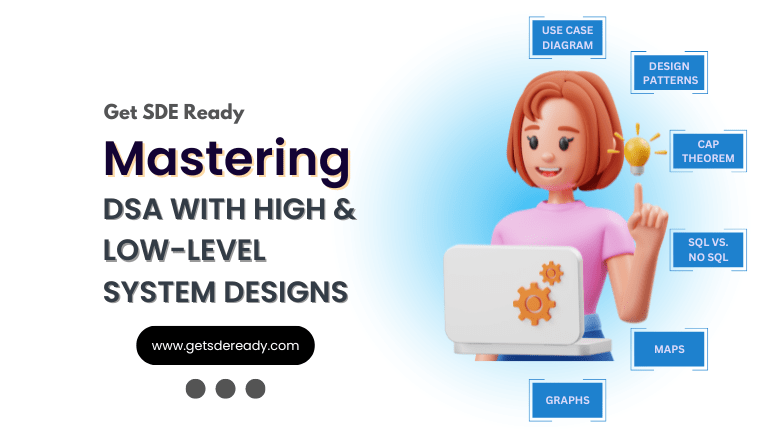
DSA, High & Low Level System Designs
- 85+ Live Classes & Recordings
- 24*7 Live Doubt Support
- 400+ DSA Practice Questions
- Comprehensive Notes
- HackerRank Tests & Quizzes
- Topic-wise Quizzes
- Case Studies
- Access to Global Peer Community
Buy for 52% OFF
₹25,000.00 ₹11,999.00
Accelerate your Path to a Product based Career
Boost your career or get hired at top product-based companies by joining our expertly crafted courses. Gain practical skills and real-world knowledge to help you succeed.
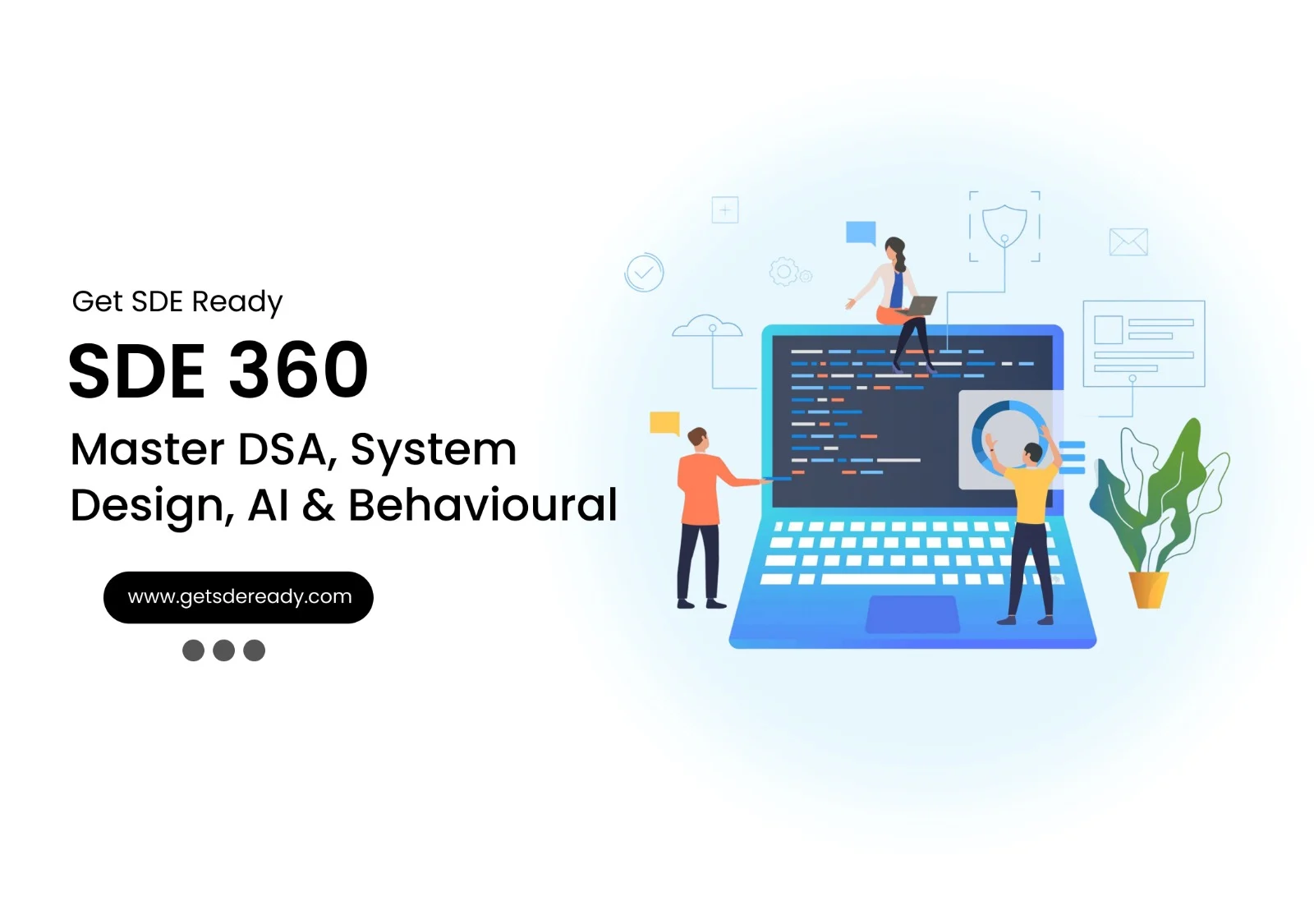
SDE 360: Master DSA, System Design, AI & Behavioural
- 100+ Live Classes & Recordings
- 24*7 Live Doubt Support
- 400+ DSA Practice Questions
- Comprehensive Notes
- HackerRank Tests & Quizzes
- Topic-wise Quizzes
- Case Studies
- Access to Global Peer Community
Buy for 50% OFF
₹39,999.00 ₹19,999.00

DSA, High & Low Level System Designs
- 85+ Live Classes & Recordings
- 24*7 Live Doubt Support
- 400+ DSA Practice Questions
- Comprehensive Notes
- HackerRank Tests & Quizzes
- Topic-wise Quizzes
- Case Studies
- Access to Global Peer Community
Buy for 52% OFF
₹25,000.00 ₹11,999.00
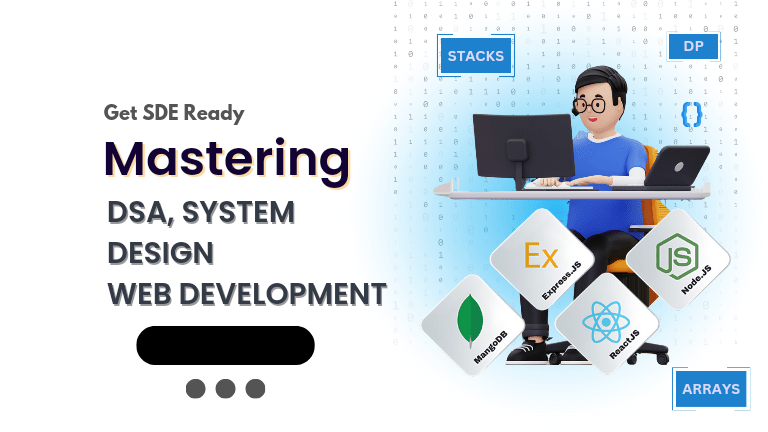
Fast-Track to Full Spectrum Software Engineering
- 120+ Live Classes & Recordings
- 24*7 Live Doubt Support
- 400+ DSA Practice Questions
- Comprehensive Notes
- HackerRank Tests & Quizzes
- 12+ live Projects & Deployments
- Case Studies
- Access to Global Peer Community
Buy for 51% OFF
₹35,000.00 ₹16,999.00

Low & High Level System Design
- 20+ Live Classes & Recordings
- 24*7 Live Doubt Support
- Case Studies
- Comprehensive Notes
- HackerRank Tests
- Topic-wise Quizzes
- Access to Global Peer Community
- Interview Prep Material
Buy for 60% OFF
₹20,000.00 ₹7,999.00
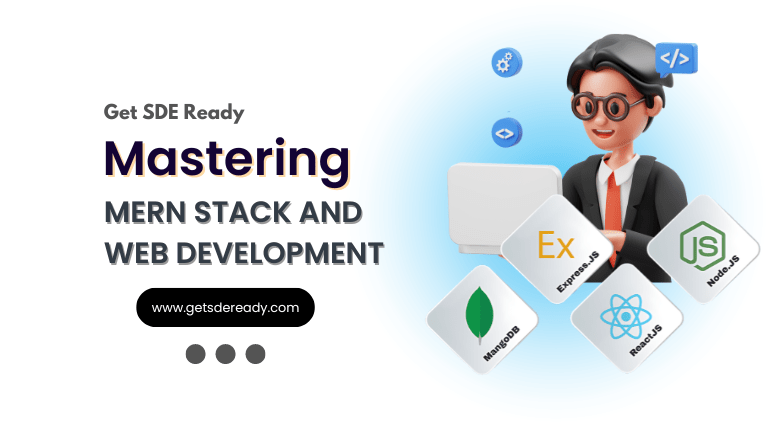
Mastering Mern Stack (WEB DEVELOPMENT)
- 65+ Live Classes & Recordings
- 24*7 Live Doubt Support
- 12+ Hands-on Live Projects & Deployments
- Comprehensive Notes & Quizzes
- Real-world Tools & Technologies
- Access to Global Peer Community
- Interview Prep Material
- Placement Assistance
Buy for 53% OFF
₹15,000.00 ₹6,999.00
Reach Out Now
If you have any queries, please fill out this form. We will surely reach out to you.
Contact Email
Reach us at the following email address.
arun@getsdeready.com
Phone Number
You can reach us by phone as well.
+91-97737 28034
Our Location
Rohini, Sector-3, Delhi-110085
